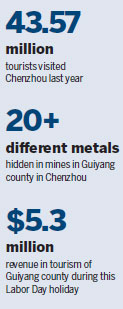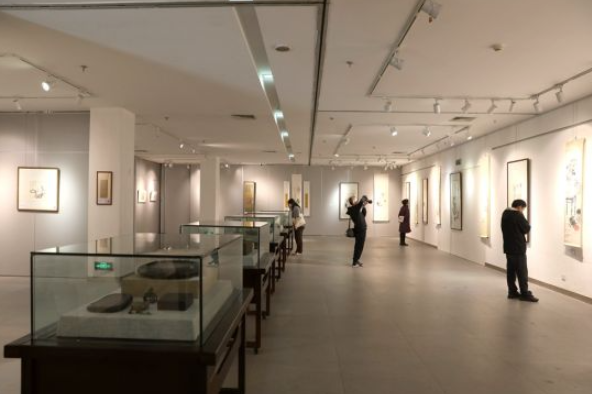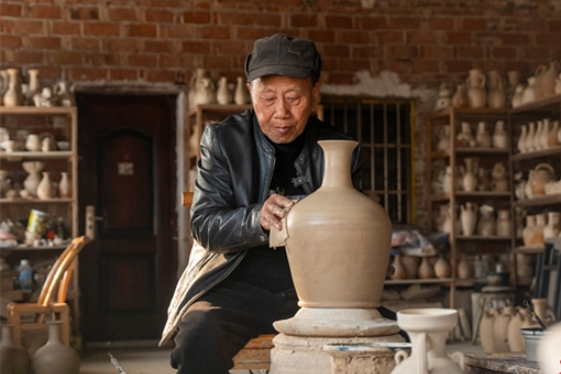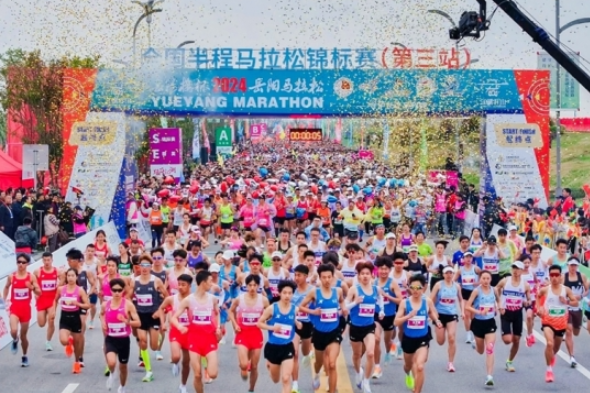Chenzhou, Hunan province, is digging into the potential of mining and metallurgy-themed tourism as new fuel for the local economy.
Baoshan National Mining Park in Guiyang county, Chenzhou, is the first of its kind in the region and is expected to be the new highlight in Hunan's tourism industry.
Baoshan, once a wasteland full of wild grass and abandoned mining pits, is now being turned into a forest reserve, thanks to the substantial investment from the local government since 2008 to save the environment and landscape.
In 2010, the country's Ministry of Land and Resources released a list of 33 qualified mineral mountains. Two are from Chenzhou: Shizhuyuan and Baoshan.
Three years later, the park officially opened for visitors with seven areas to offer a wide selection of fun activities and services, including a visitor center, a mining experience zone, an exhibition of metallurgy traditions, an open mining area, an outdoor training camp and a metallurgy museum.
The tour of the mining theme park is both exciting and educational.
Splendid geographic features are hidden 300 meters below the ground, including colorful stalactites and copper-affected green underground waterfalls.
In addition to the natural miracles, the well-preserved mining workplace offers tourists a glimpse into the thousand-year history of mining techniques, from Tang dynasty (618-907) to the modern age.
When seeing the largest copper coin ever made in the world - 24 meters tall and 3.8 meters thick - visitors were surprised.
"I wanted to come here a long time ago and I finally experienced the profound metallurgy culture of Guiyang county. It is totally worth visiting," said Liu Xiwen, who visited with his family from Shenzhen.
Chenzhou is slowing turning itself into a museum of colored metals, mineral crystals and mineral mountains.
Currently, it has already set up two museums and two natural parks.
An international jewelry cultural innovation industrial park is currently in the planning stage.
An additional project for a stone exhibition park is also listed in the local governments' agenda. The exhibition park will be used for education activities, culture innovation, entertainment and trade.
It will feature in the upcoming mining expo.
According to the local tourism bureau, during the Labor Day holiday, the county hosted 163,000 visitors, generating 36.8 million yuan ($5.3 million) in revenue, a 22.8 percent increase year-on-year.
Last year Chenzhou welcomed 43.57 million tourists and gained 32.5 billion yuan in revenue from tourism, up by 12.9 percent and 15.6 percent year-on-year, respectively.
The idea of the park originated from the abundant natural resources and the area's long history of mining and metallurgy.
Guiyang has long been known for its wide variety and large quantity of colored metal resources, including lead, zinc, gold, silver, copper and tin.
Yi Pengfei, Party secretary of Chenzhou, said the city is aiming even higher. It is currently planning an economic belt powered by minerals and natural gemstones, focusing on exhibition, tourism, jewelry and culture.
Mining history in Guiyang county dates back to the Han Dynasty (206 BC-AD 220).
The area later became a currency-making base during the Tang Dynasty.
Today there are mines for over 20 different metals and more than 10 nonmetal mines were detected in the county, comprising over 30 million tons of black lead reserve.
The annual production of black lead from Guiyang accounts for a third of total national production.

Mining becomes tourist attraction to fuel economy
Editor:张焕勤
Source:中国日报
Updated:2017-05-17 10:34:51
Source:中国日报
Updated:2017-05-17 10:34:51
Special
Contact
Welcome to English Channel! Any suggestion, welcome.Tel:0731-82965627
lisl@rednet.cn
zhouqian@rednet.cn











